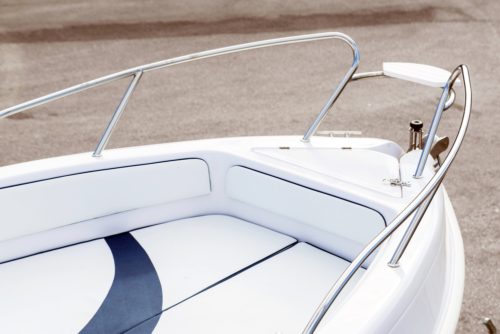Vinyl Fabric Tips
3 Tips for Adding Coaming Bolsters to Your Boat
It is standard for new boats to come with coaming bolsters, but most older boats, and a few lower-end current models, are lacking this amenity. Coaming bolsters are pads made from foam and marine vinyl fabric that help provide cushion and comfort to the inner walls, or inwales, of your boat.
An errant wave causing you to stumble into or slap your legs against the inwale can make for a pretty uncomfortable experience for you and your guests. If you’re tired of painful slips resulting in bruises, here are some tips on how to acquire and install coaming bolsters with relative ease.
Place the Order
Unless you have a top-of-the-line sewing machine and skills to match, you will need to hire a marine-upholstery shop to build your bolsters. Communicating what your specific needs are with a shop is a crucial step in the manufacturing process.
Provide accurate measurements to the upholsterer to ensure an appropriately sized coaming pad. If for any reason you are unsure about your measurements, asks for the shop to send someone to help you measure.
Choose the Right Back Board
You have two choices when it comes to which back board you are going to mount your pad to: wood or Starlite. Determining which material you prefer will mostly depend on your budget. Starlite is a high-quality, durable, marine-friendly material that will last through multiple coaming board replacements.
However, if you are trying to keep your project as inexpensive as possible, marine plywood will work well, and at about half the cost. The drawback of marine plywood is that it is much less durable and will only last through one or two pad replacements. Most quality marine upholsterers will attach the pad to the backing board for you as part of their service.
Attach the Coaming Bolster
Your method of installation will depend on the type of inwales your boat has. If you have access behind the inwales, it is best to install with studs. Before your upholsterer attaches the pad, be sure to attach quarter-inch studs every eighteen to twenty-four inches through the front of the backing board. This approach provides a robust and durable installation.
If you don’t have access behind the inwales, vinyl tracking is the optimal method of installation. This process places a track at the top of the inwale and at the bottom of where the bolster will be. The bolster then slides into the track to secure the backing board to the inwale. If this is your method of installation, inform your upholsterer that you will need a heavy-duty keder welt on the bottom and top of the bolster for stability.
Unexpected turbulence on the water doesn’t have to be a painful experience, and neither does the installation of a coaming bolster. Follow these steps to make for a more comfortable boating experience for you and your boatmates. For additional information or any marine vinyl fabric needs, contact All Vinyl Fabrics or call (877) 618-4695 today.
